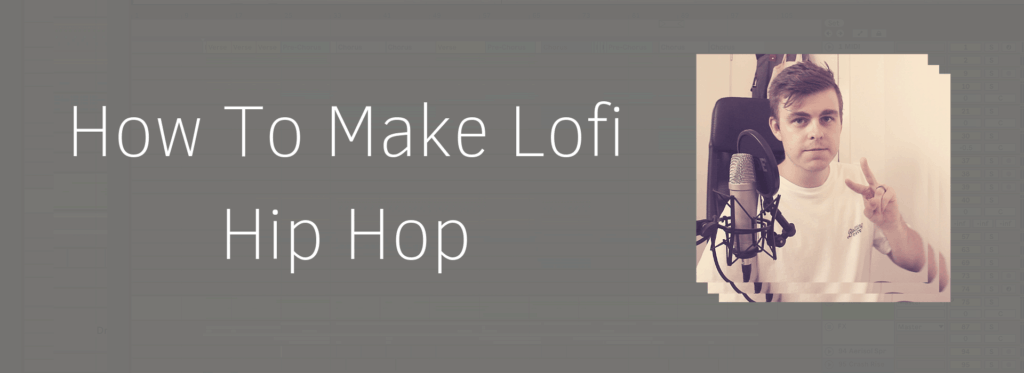Want to learn lofi hip hop with 3 step-by-step walkthroughs? Check out The Lofi Hip Hop Blueprint (currently 70% off)
Ever seen those ’24/7 lo-fi hip hop beats to chill/study/relax to’ streams? Because of this, the genre is growing and people want to know how to make lo-fi hip hop.
The problem is, the sound is low-quality on purpose as part of the aesthetic. It’s a throwback to old-school hip hop when computers weren’t a big part of the production, and the technology wasn’t up to scratch.
So the production techniques we get into in this video/article help to be able to make lo-fi hip hop while combining a gritty sound with a modern workflow. You can watch the video, read the article, or do both.
So let’s hop into our 5 step process that breaks the production process down! 👇
Want better lofi sounds? 🔊
Download our FREE lofi hip hop sample pack (includes: 10 kicks, 10 claps/snares, 7 hats, 7 melodic sounds and 23 foley/fx) 👇
How To Make Lo-fi Hip Hop
- Nostalgic Chords and Melody
- Dusty Drum Beat
- Infectious Bass Line
- FX and Creative Elements
- Mixing and Mastering
Note: this isn’t a beginner’s tutorial. If you after something more introductory, then check out our electronic music guide.
Getting in the Zone
One thing I mention in the video is that lo-fi hip hop is quite a moody
One thing that helps me write in this genre is getting into a specific headspace before, by recalling a memory from my
Being in this frame of mind will help guide the creativity in the production process, but make it suited to your workflow and specific situation.
So take a few minutes to prepare yourself before just jumping into the studio – you’ll thank me later.
Prepare your project file by setting the BPM between ~70-100 and by making sure you have all your sounds at hand.
Once you’re ready, let’s begin with step 1.
Step 1: Nostalgic Chords and Melody
So when it comes to lo-fi hip hop, sampling chords and melodies is commonplace, especially from old funk and jazz records. But you can also just write your own progression.
In this example, I’m going to write my own and resample it to show you both workflows. It’s also a lot of fun to work in audio.
So find a sound that suits the vibe of the track you are going for. In the video, I went for a Rhodes/keyboard type sound.
If you’re in Ableton, there is a nice variety of ePiano and Rhodes-type instruments that work nicely.
FL Studio additionally has FL Keys with a decent Rhodes preset.
Once you’ve got a suitable sound, create a new clip
Once you’re done, freeze and flatten the audio (right-click on the track and select freeze, wait and then select flatten). If you’re in another DAW like FL Studio, simply record the audio into Edison and drop it back into the arrangement.

Now you can treat the chord progression like audio and chop it up into a new arrangement, and get that chopped hip hop vibe from taking segments of audio.
You can do this in audio or by slicing it to a Drum Rack (or Slicex in FL). Additionally, you can pitch the audio up or down to change the tone.

This way of working contributes to the overall sound of lo-fi hip hop and is a nod to an MPC-type workflow.
You can create a few varieties of pattern to see what works best, and even swap between them throughout the structure of your track.
Once you’ve got some solid chords in your DAW, let’s move onto one of the key ingredients in a lo-fi beat.
Want better lofi sounds? 🔊
Download our FREE lofi hip hop sample pack (includes: 10 kicks, 10 claps/snares, 7 hats, 7 melodic sounds and 23 foley/fx) 👇
Step 2: Dusty Drum Beat
Drums are super important in most electronic music, let alone lo-fi hip hop. But in this case, you can’t use any old drum samples, you need them to sound crunchy and dusty.
The easiest way to do this is to find appropriate samples in the first place. You can do extra processing, but minimising the amount of post-FX on the sound makes the process much more efficient and easy.
Look for a kick, hats, and a snare that share similar aesthetics, usually with background noise, lots of compression/saturation, and less high-end information.
You can find samples on Splice Sounds or on r/drumkits (good specifically for this type of drum sound). If you’re struggling, try taking one-shots from older drum loops. Once you’ve got some sounds, load them up into a drum rack or some sort of drum sampler.
The sound is important, but the beat itself is quite straightforward. Simply make a beat with the following pattern. Feel free to vary it to your own taste.
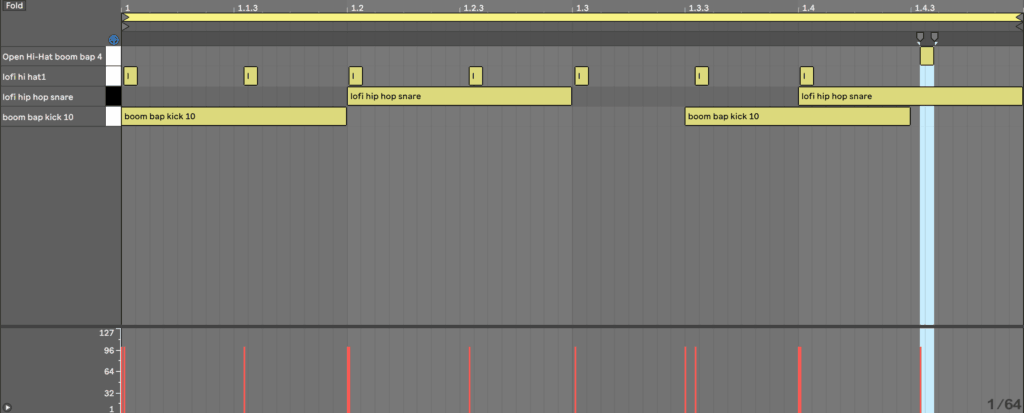
The kick and the snare usually are quantized (or close) to the grid, and the second kick for every bar is featured on the offbeat. You can see this in the pattern above.
This is typical in lo-fi hip hop, but you can experiment with other patterns to mix things up.
Swing is crucial in hip hop as it creates a more relaxed atmosphere to the track, so feel to bring the first hat back a bit and the second a bit forward, and repeat with slight differences each time. You’ll hear what I mean.
Featuring an open hat as the last in the pattern adds a sense of continuation and interest to the beat. So feel free to mess around with a variety of hat sounds.
Group processing on drums is very important, as doing this not only (once again) contributes to the aesthetic, but helps to glue the drums together for a more cohesive sound. Some good processing tips are:
- Low-pass filtering
- Saturation
- Compression
- Transient shaping
- Pitch adjustments
By the end, you should have something like this.
Altogether with the drums, this is the loop we have come up with.
Want better lofi sounds? 🔊
Download our FREE lofi hip hop sample pack (includes: 10 kicks, 10 claps/snares, 7 hats, 7 melodic sounds and 23 foley/fx) 👇
Step 3: Infectious Bass Line
Bass in lo-fi hip hop is usually quite mellow but rhythmically interesting. From interesting loops to full-blown bass solos, it’s possible and it works.
To start, find a bass sound with a focus on the low end but with some nice harmonics. A simple sine wave might do, but try running it through a bit of saturation/distortion to beef it up a little bit.
Now we will make a bassline based on our original chord progression, using chord tones. It doesn’t necessarily have to follow the root note, but that might be a good starting point.
It’s important to take it beyond this though, by adding rhythmic variety like syncopation, moving notes up an octave and a lot more.
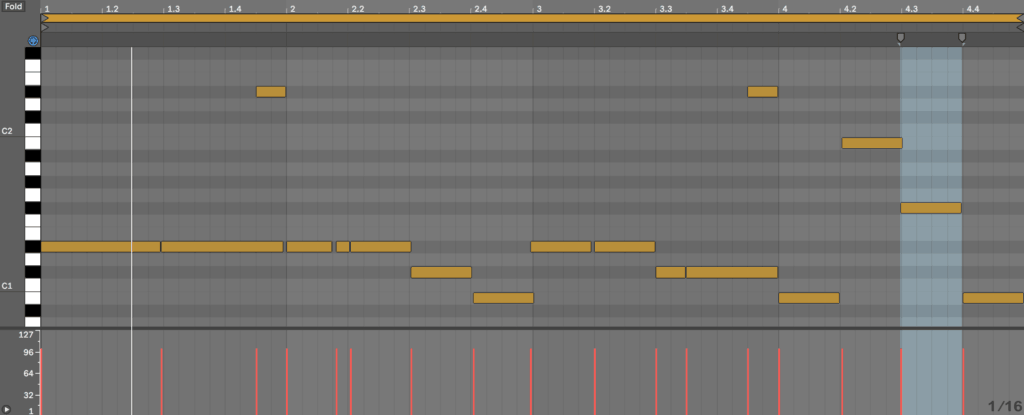
Once you have a bass line that fits with the chords, blend the volume to allow it to sit nicely. It doesn’t have to be perfectly mixed for now, but just enough so it compliments nicely.
Step 4: FX and Creative Elements
One key effect to add into a lo-fi track is vinyl crackle, to emulate the sound of a record player which helps to contribute to the dusty/sampled aesthetic.
So find a nice sample, try low-passing it to see if it sounds more suited, and make sure to turn it down into the background of the track.
You can combine this with foley elements to add nice intimate textures that ‘weave’ in and out of the crackle.
Apart from that, there isn’t a hard and fast rule for FX in lo-fi hip hop, although you tend to hear a lot of pitchy ‘bleep-bloop’ type sounds (for lack of a better term).
You can find a lot of impact and riser FX samples with this kind of sound, but they aren’t too hard to make yourself.
Simply automate a wave’s pitch with an LFO and adjust the rate and amount, while applying delays and the sort. You can have a lot of fun making these types of FX.
Find other suitable effects: chimes, foley, background percussion, sweeps, computer sounds, you name it.
Lastly, a sampled vocal speech can add a certain type of atmosphere to the track. Try finding a speech from a sample pack and processing it with EQ and distortion effects. This helps to achieve a gritty sound that compliments the rest of the beat.
As a side note, you can do some crazy processing like pitching the whole master up or down, as per the video.
But after that, you should have something that’s starting to sound a little more developed, like this.
Step 5: Mixing and Mastering
Mixing and mastering are pretty lax in the realm of lo-fi hip hop. To be honest, as long as your faders are set well (which is harder than it sounds), then you’re most of the way there.
Mixes tend to be on the more dynamic side, as the kick and snare punch through to give the track a nice groove to focus on. The bass is set fairly loud to give the track a solid foundation, and everything else including hats, chords, FX, and melodies can be mixed according to the track’s needs.
If muddiness is becoming a problem, try cutting the lows in some sounds. This can occur specifically when pitching sounds down a lot, which we did earlier with the chords. The fundamentals are pushed down into the lower mids/upper bass frequencies.
You’ll also be wanting to sidechain a lot of the elements to the kick drum in the drum rack. In lo-fi hip hop, you can get away with a more brutal form of sidechain compression, as it’s part of the aesthetic.
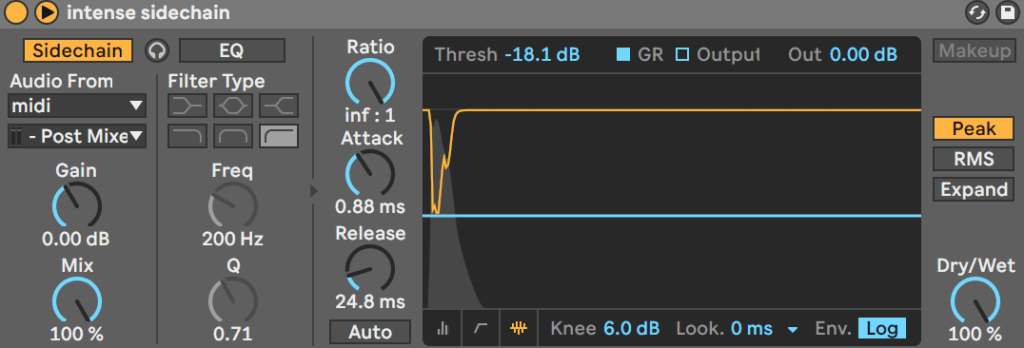
After that, you can usually get away with mastering it just with some limiting and/or soft clipping. At the end, you should have something like this!
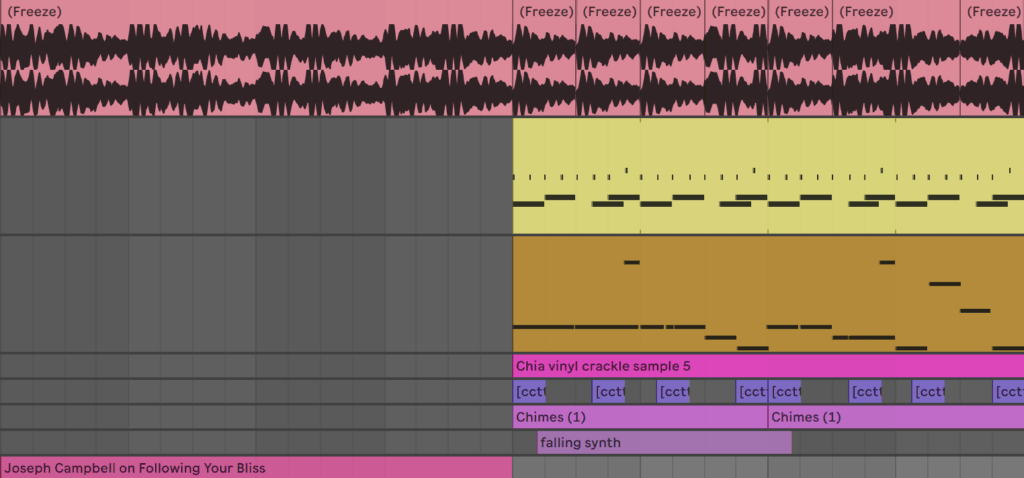
Need the Sounds?
So it’s all well and good that you know how to make this genre now, but what about having good quality samples to use?
Well, you can get our FREE lofi hip hop pack below!
Want better lofi sounds? 🔊
Download our FREE lofi hip hop sample pack (includes: 10 kicks, 10 claps/snares, 7 hats, 7 melodic sounds and 23 foley/fx) 👇
Hopefully, this helps you get off the ground with lo-fi and that you’ll be making beats like this in no time.
If there’s anything I missed or you have any questions, drop me an email at [email protected].
Want the most comprehensive course on lofi hip hop out there? Check out our latest course, The Lofi Hip Hop Blueprint.

